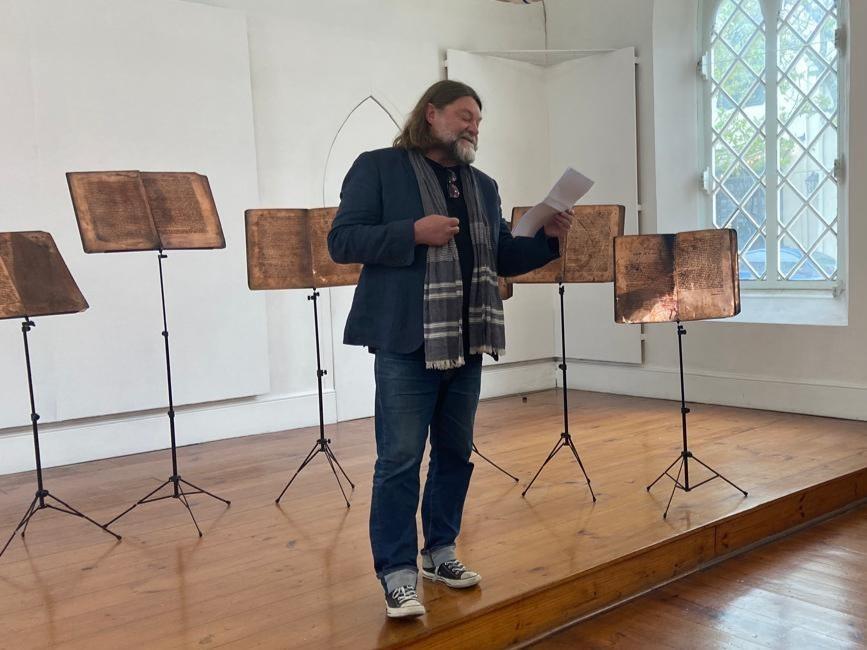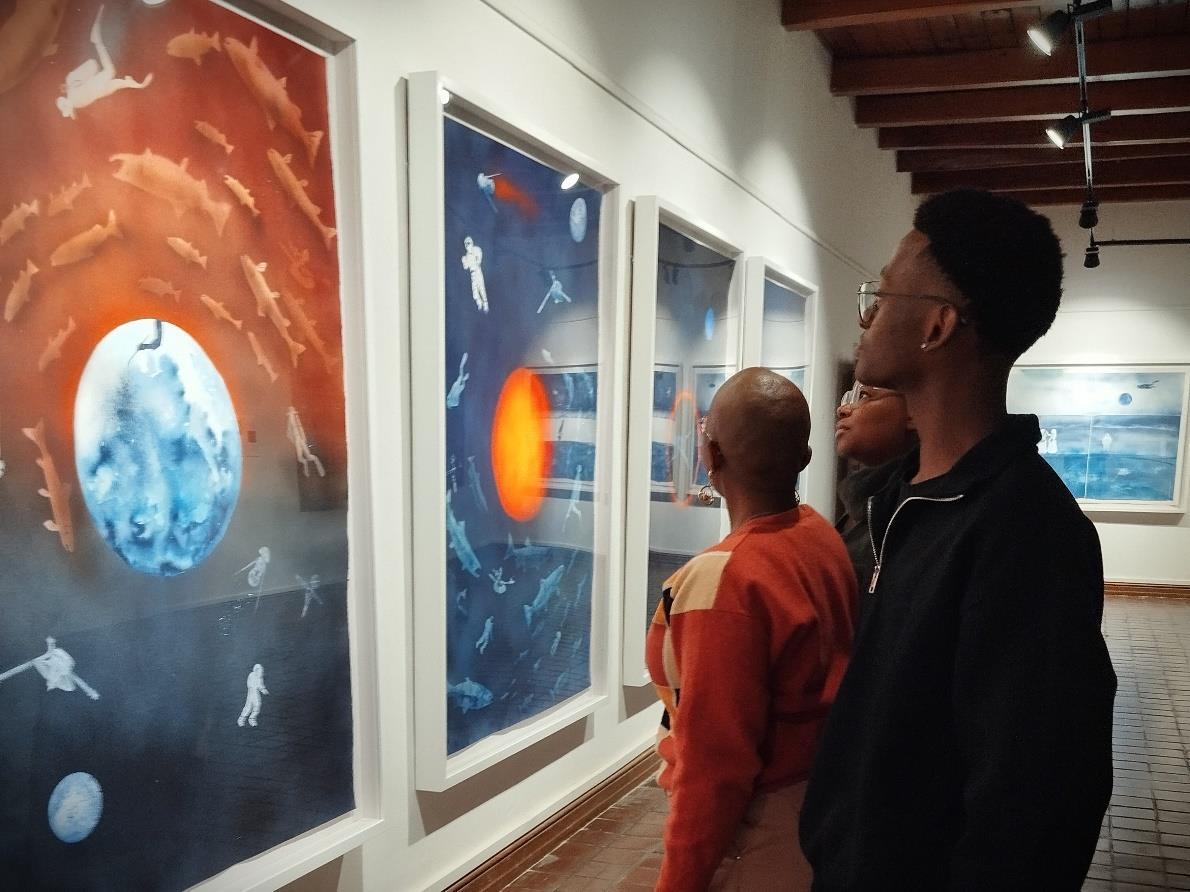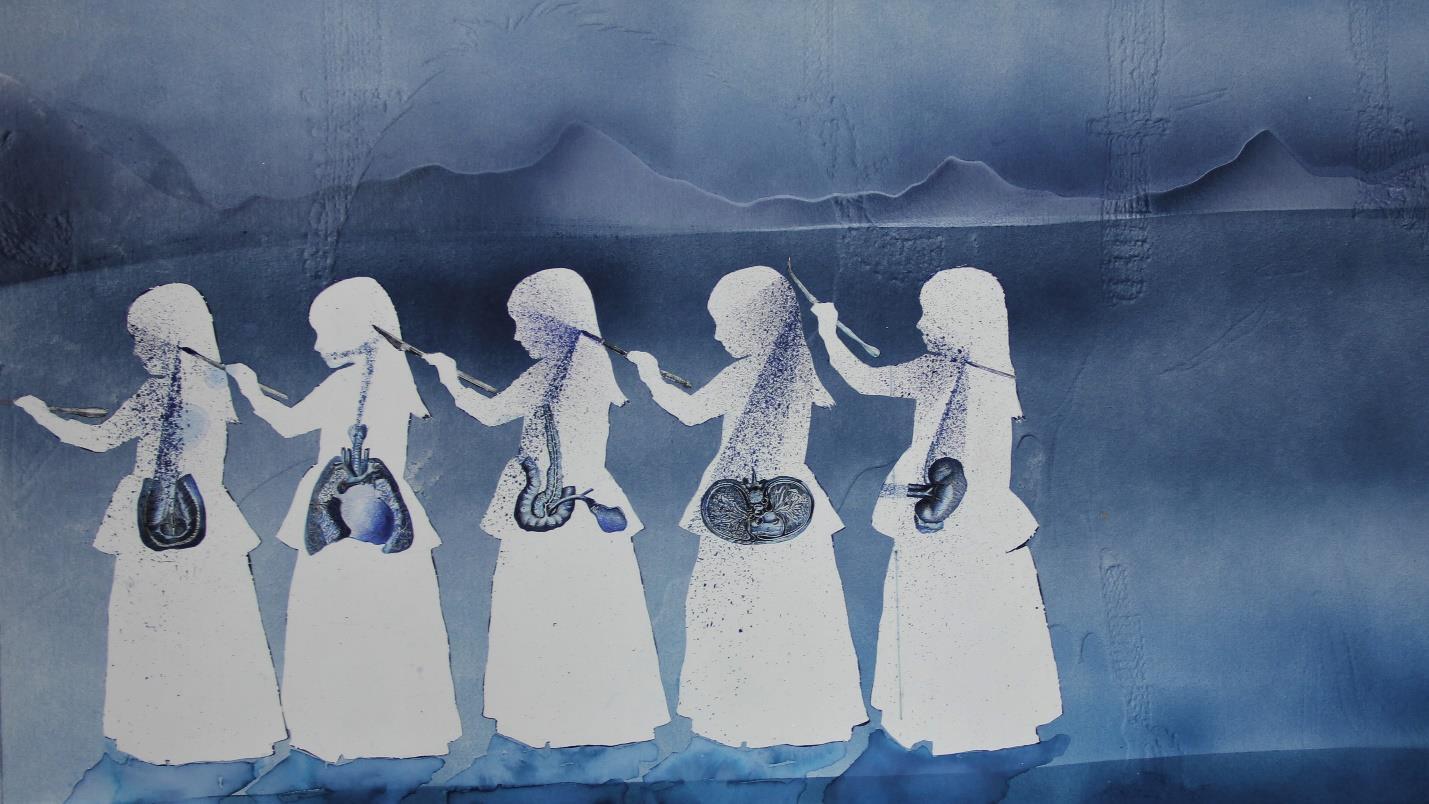Between entrapment and infinitude: Imagination and truth in the art
of
Christine Dixie
Andries Bezuidenhout
ITexts are creative, but texts control. Books open our minds, but books in the form of passports and refugee papers either allow people to move or fix them in place. Those in power – with knowledge and papers – cross borders freely. They are tourists in space. Those without the required papers, the undocumented, move surreptitiously – at times they drown.
I encountered Christine Dixie’s art for the first time Johannesburg, in an unpretentious Melville art shop called Art on Paper. The work etched out a Karoo landscape – there was a mountain, a house, and a body buried under the landscape. More than two thirds of the landscape was taken up by soil – surface
and underground merged into one, with the buried corpse, almost fetus like in posture, as counterpoint. This is how I remember the image.
“Toorberg,” Irma du Plessis remarked, referencing Etienne van Heerden’s novel about landscapes and the histories that lie beneath. We both fell in love with Christine’s work. Landscape, layers, history – art as the imaginative excavation of meaning. Or, in sticking with the Foucauldian theme of this exhibition – art as archaeology.
Back in Melville, Irma made a connection between image and text. Blueprint for the DisOrder of Things as an exhibition explicitly explores tensions between text and image, between planning (blueprints) and the unexpected (pest), between order and disorder. Central to the exhibition is a text that engages an image, namely Michel Foucault’s early work The Order of Things: An Archaeology of the Human Sciences, first published in 1966. Foucault excavates shifts in how people understood the world from the renaissance and the classical era, through to the emergence of Kantian rationalism, or modernity. Diego Velázquez’s painting “Las Meninas”, from 1656, plays a central role in The Order of Things.


The book opens with a lyrical discussion by Foucault of how the painting draws on classical composition in art, but how the painting invites multiple ways of viewing the work. It skillfully puts the viewer of the painting in the position of the ostensible subject of the painting – the Spanish royal couple, whose portrait is in the process of being painted. We know they are there, because we see them in a mirror and the artist, standing in front of his canvas, looks at them. Or does he, through time, look at us? The painting is a portrait of the royal couple, but it is
also one of their daughter, the Infanta Margaret Theresa, her ladies in waiting and other courtiers, including two court jesters, and a dog. It is also a portrait of the artist, the one who orders the images on the canvas, itself a material object represented in the painting.
Because of this interrogation of how we position our gaze – of what we consider as an objective position to view the world from, and what we perceive as the subject of our investigations, Foucault saw “Las Meninas” as a work of art that signifies a shift from classical understandings of the world to the reflexive nature of Kantian rationalism. In The Order of Things, Foucault’s archaeological excavation explores shifts in meaning in art, biology, and economics. The book itself was an instant classic.
II
What was radical in the domain of philosophy in 1966, when Foucault published The Order of Things, is now commonplace. The postmodern condition is no longer a prediction, but a reality, and the seemingly progressive need to deconstruct fixed understandings run up against rightwing conspiracy theories, AIDS denialism, and a revival in race and gender essentialisms. Religious fundamentalist understandings of the order of things have made a spectacular comeback. Necessary skepticism of claims made in the name of science has morphed into hostility towards science. Non-biological forms of intelligence have become a reality and break out of the domain of science fiction. What we call AI now even makes art. Finally, at stake is also understandings of the survival of the planet and many of its species, including our own.
It seems, but maybe it always does, that we are on the cusp of something new –that we find ourselves, like the characters in “Las Meninas”, at a moment when one historical epoch makes way for another. How do we make sense of this?
Much of the work in this exhibition was created during the Covid-19 lockdown. Perversely, for those of us who had shelter and an income, this provided a terrifying moment of reflection. This is part of the story of Blueprint for the DisOrder of Things – how the ways in which we order and do things can be altered by a virus. This is both new and old – and from the constrained room depicted in “Las Meninas” emerge several characters. They leave the canvas and change appearance. We still recognize them, but they become new. A jester turns into a doctor, subject becomes artist, those entrapped in a room become travelers –from Europe, to Damascus, to Alexandria, all the way to Makhanda.

In their travels there are maps, charts, blueprints – texts that lead the way. But text also becomes object. In the “Blueprints ensemble” installation, copper plates used to print the text for The Order of Things jump up onto music stands and invite the onlooker to sing from text as sheet music. The scene depicted in “Las Meninas” is part of this text-as-picture, as art, as object. We view it in new
contexts, we are invited to attach our own meaning to classical images and texts that once were considered modern and cutting edge, now nostalgically etched into copper plate. In times of artificial writing, where the author has truly died, we are reminded of the materiality of the book, the map, text as represented image hammered by typewriter onto paper or chisel and press onto copper, then inked and transferred onto paper.
In both the sequences titled “Out of the blue” and “Ghostprints for the Infanta”, characters break free from oil paint on canvas and become textile. Like flags they move, they become ephemeral, they are recovered from the seriousness of pigment solidified in linseed oil and now literally move along with cotton cloth. They travel through time and go where they do not belong – a scuba diver is not allowed to traverse the vacuum of space, an astronaut should not swim below the surface of the ocean. Yet they do, and question the order of things, like the mirrors in “Las Meninas” – water is a mirror, and so is the thin meniscus that covers our fragile planet.

In the Blueprint sequence, the Infanta and the dog are depicted as figures with text from The Order of Things on a landscape, at times the landscape is text. We also see the Infanta’s inner organs – she moves as a sketch from a medical text. But she also creates – she draws images of herself. The subject becomes and active agent in her own making, drawing and redrawing images of herself. In another Ghostprint sequence, the artist highlights words from Foucault’s text and creates new meaning – much like the cut-out poems of the beat poets from the 1950s.
III
For a year, things stood still, were frozen in time. Did we use the time to reflect? When movement returned, it did so in the form of soldiers and missiles. This is the historical order of things. Pest, followed by war.
Of course, we do not expect art to solve our problems – at most, it challenges us, but it can also soothe and comfort. Art is at its worst when it is didactic and at it best when it intrigues us, when meaning has layers and when we are invited to take another look, and another look. On the topic of lockdown, I would like to quote JM Coetzee out of context, but I think his words still make sense today, even though, at the time, he referred to South Africa in the late period of apartheid:
As you would expect in so physically vast a country, there is a South African literature of vastness. Yet even that literature of vastness, when examined closely, reflects feelings of entrapment, entrapment in infinitudes [...] The crudity of life in South Africa, the naked force of its appeals, not only at the physical level but at the moral level too, its callousness and its brutalities, its hungers and its rages, its greed and its lies, make it as irresistible as it is unlovable [...] We have art, said Nietzsche, so that we shall not die of the truth. In South Africa, there is now too much truth for art to hold, truth by the bucketful, truth that overwhelms and swamps every act of the imagination.1
In this specific text, Coetzee refers to Cervantes’ novel Don Quixote, written at the time when Velazquez painted “Las Meninas”. At the time, the novel’s imagined world was an open landscape of castles, windmills, and open plains. It also raised
1 Quoted from Coetzee, J.M. 1992. Doubling the point: Essays and interviews. Cambridge and London: Harvard.
questions of the imagination and how we come to know what we know –between truth and illusion. From Cervantes the novel moved on to Kafka – a world characterized by the iron cage of bureaucracy, by rules, regulations, a fixed order of things – or the biopolitics of governmentality, as Foucault would describe it.
This exhibition invites us further into the future, where the human body is placed not in a room, but in an ecological landscape. The dog from the painting – a bit player, prodded by the court jester as amusement for the Infanta – becomes a main character, joined by owls, fish, dolphins. In the post-truth world, in the world where scientists and politicians have standoffs over whether there is a climate crisis or not, over whether we can refer to the current geological epoch as the Anthropocene or not, where the very basis of our claims to truth are so deeply contested, the return the Foucault’s discussion of “Las Meninas” makes perfect sense.
The works of art – the images, the objects, the texts, the sounds – that collectively make up Blueprint for the DisOrder of Things call on us to reconsider how we position ourselves in this world. It is a profoundly beautiful and moving exhibition,
but it is also one that is intriguing and challenging in the best possible way, because it engages the imagination to consider the very basis of what we consider to be true. In the mirror is not a royal couple, but ourselves – along with all the other animals we so keenly order and classify.









